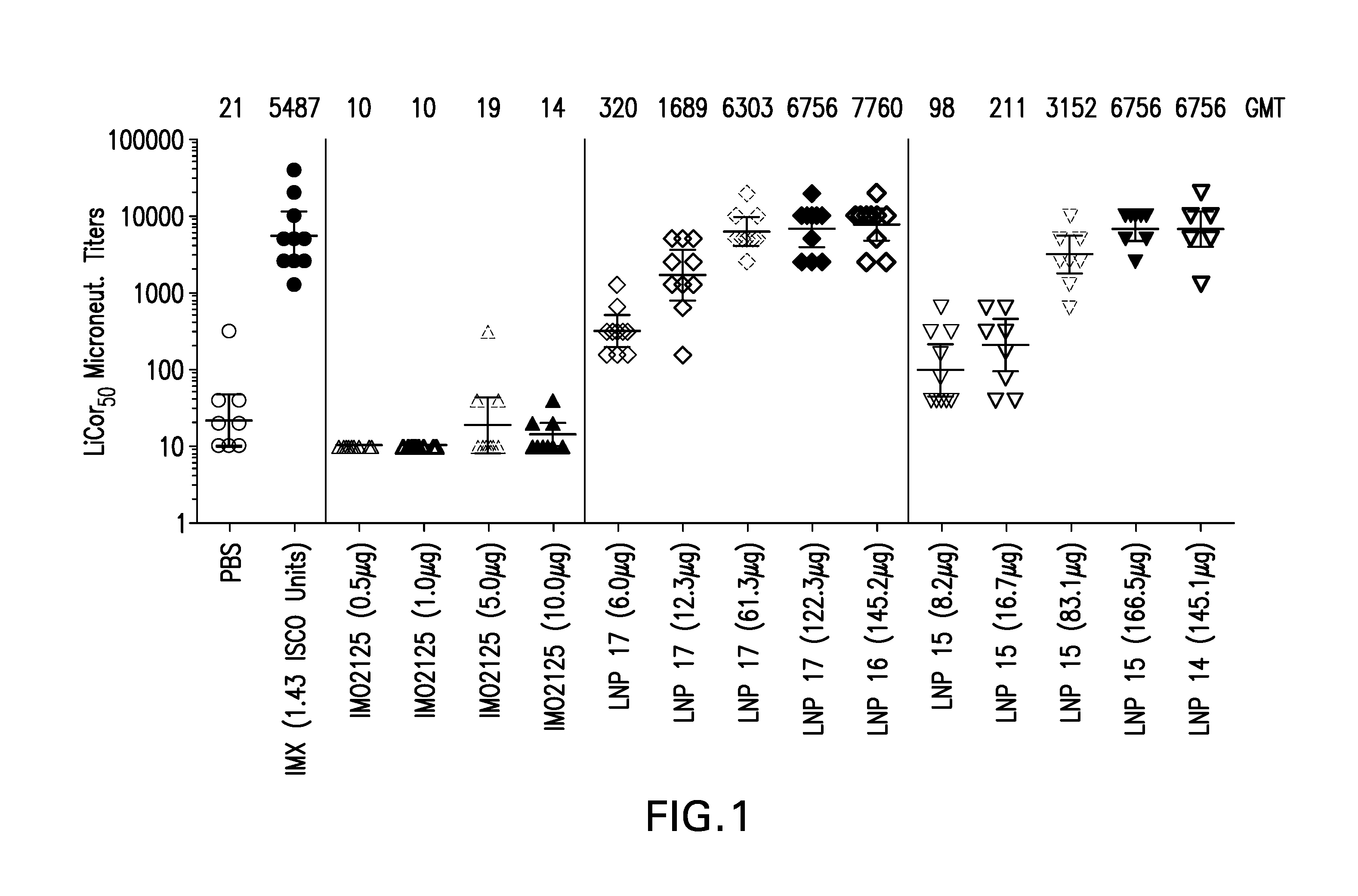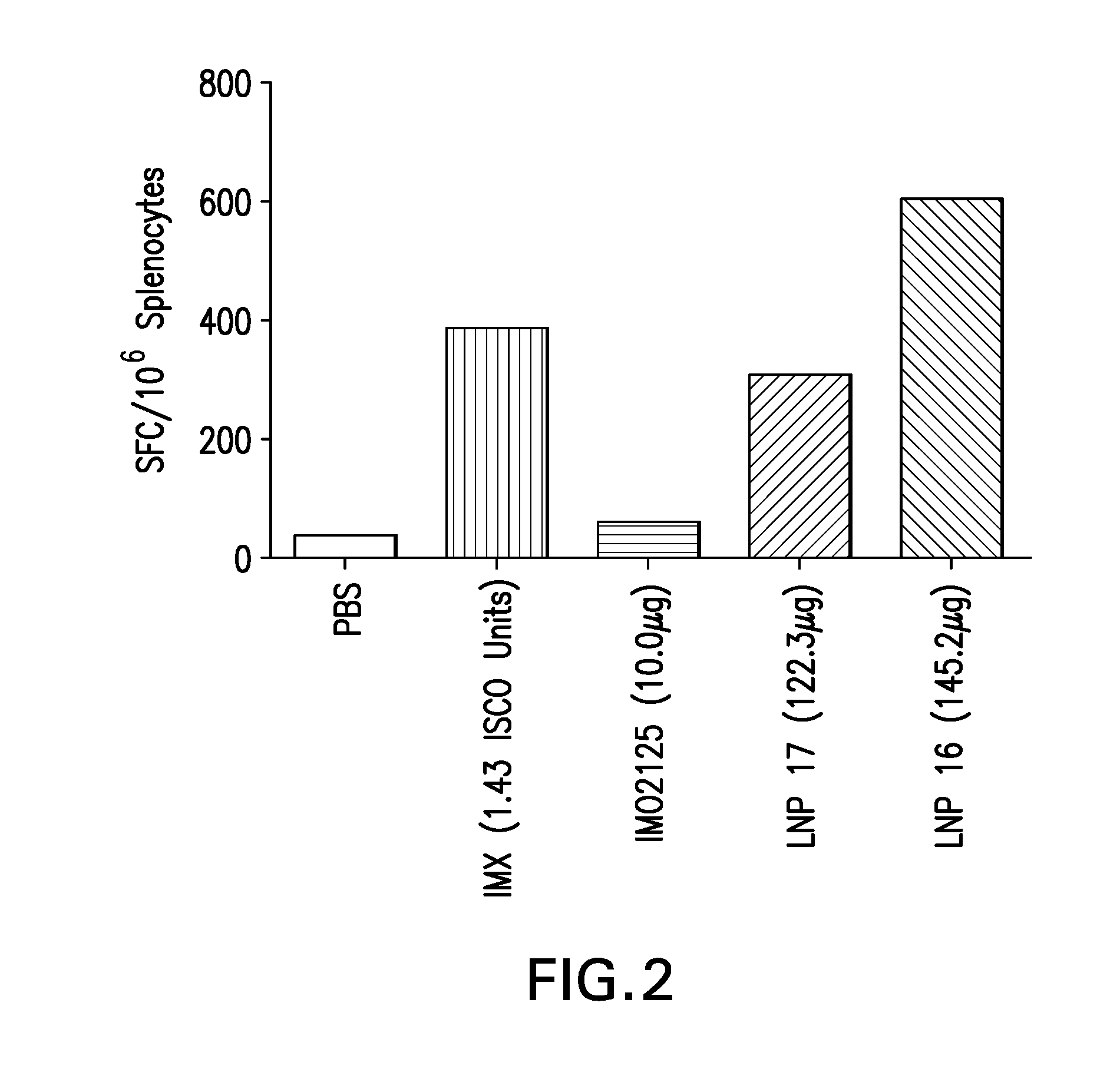Lipid nanoparticle vaccine adjuvants and antigen delivery systems
- Summary
- Abstract
- Description
- Claims
- Application Information
AI Technical Summary
Benefits of technology
Problems solved by technology
Method used
Image
Examples
example 1
Preparation of Basic LNP Compositions
[0170]The lipid nanoparticle (LNP) compositions of Table 3, with the specified molar concentrations of cationic lipid 9 from International Patent Application Publication No. WO2011 / 022460 (compound 1-9) or cationic lipid 32 or 33 from International Patent Application Publication No. WO2012 / 040184 (compound 2-32 or compound 2-33, respectively), cholesterol, PEG-DMG, and optionally DSPC, were prepared as described in detail below.
TABLE 3Lipid Composition of Basic LNP CompositionsLipid LNPCompositionIdentifierLipid Components(molar ratio) 1Cationic Lipid / Cholesterol / DSPC / PEG-DMG40 / 48 / 10 / 2 2Cationic Lipid / Cholesterol / DSPC / PEG-DMG58 / 30 / 10 / 2 3Cationic Lipid / Cholesterol / DSPC / PEG-DMG59 / 30 / 10 / 1 4Cationic Lipid / Cholesterol / DSPC / PEG-DMG42 / 41 / 15 / 2 5Cationic Lipid / Cholesterol / DSPC / PEG-DMG38 / 41 / 19 / 2 6Cationic Lipid / Cholesterol / DSPC / PEG-DMG33 / 41 / 24 / 2 7Cationic Lipid / Cholesterol / DSPC / PEG-DMG43 / 41 / 15 / 1 8Cationic Lipid / Cholesterol / DSPC / PEG-DMG39 / 41 / 19 / 1 9Cationic ...
example 2
Preparation of Lnp Formulations Containing TLR Agonists
[0176]Lipid nanoparticles (LNP) formulations encapsulating immunostimulatory oligonucleotides (also referred to as immune modulatory oligonucleotides (IMO)) or Glucopyranosyl Lipid A (GLA), were prepared as described in Example 1 with the following modifications. The LNPs were formed by micro-mixing lipids dissolved in ethanol with an aqueous solution containing the IMO2125 (TLR9 agonist) or GLA (TLR4 agonist), using a confined volume mixing apparatus. The aqueous solution consisted of a sodium citrate solution [20 mM sodium citrate] with pH in the range of 5-5.5. For compositions containing TLR9 agonist, IMO2125 was added to the aqueous solution to obtain the specified final wt / wt percentage. For compositions containing TLR4 agonist, GLA was included with the other lipids in ethanol to obtain the specified final wt / wt percentage.
TABLE 4Compositions of LNP Formulations containing TLR agonistsAgonistCompo-sition(wt / wt %LipidTLRag...
example 3
Particle Size Optimization
[0180]LNPs were prepared as described in Example 1. The alcohol and aqueous solutions were combined in the confined-volume mixer with a ratio in the range of 11:1.5 to 2.1:3.8 to produce 40-55 vol:vol % alcohol in the mixed solution. The combination of ethanol volume fraction, reagent solution flow rates and t-mixer tubing ID utilized at this mixing stage had the effect of controlling the particle size of the LNPs between 30 and 300 nm.
TABLE 5Particle Size Optimization of LNP FormulationsParticleSizeLipidTLRLNPDistributionLNPCompositionAgonistDiameterIndexIdentifierLipid Components(mole / mole)Component(nm)(PDI)252-32 / Cholesterol / DSPC / 58 / 30 / 10 / 2not 600.23PEG-DMGapplicable162-32 / Cholesterol / DSPC / 58 / 30 / 10 / 2not 890.12PEG-DMGapplicable262-32 / Cholesterol / DSPC / 58 / 30 / 10 / 2not1560.18PEG-DMGapplicable272-32 / Cholesterol / DSPC / 58 / 30 / 10 / 2not2390.14PEG-DMGapplicable
PUM
| Property | Measurement | Unit |
|---|---|---|
| Electrical conductance | aaaaa | aaaaa |
| Immunostimulation | aaaaa | aaaaa |
Abstract
Description
Claims
Application Information
 Login to View More
Login to View More - R&D
- Intellectual Property
- Life Sciences
- Materials
- Tech Scout
- Unparalleled Data Quality
- Higher Quality Content
- 60% Fewer Hallucinations
Browse by: Latest US Patents, China's latest patents, Technical Efficacy Thesaurus, Application Domain, Technology Topic, Popular Technical Reports.
© 2025 PatSnap. All rights reserved.Legal|Privacy policy|Modern Slavery Act Transparency Statement|Sitemap|About US| Contact US: help@patsnap.com



